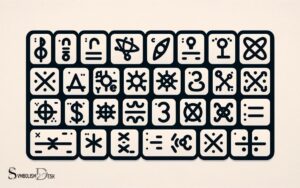What Is the F Symbol in Math? Calculus! Calculus!
The ‘F’ symbol in mathematics is used to denote various concepts such as fields in algebra, functions in calculus, and the F-distribution in statistics.
It is a versatile symbol with applications across different mathematical areas and even extends into physics, representing force. The letter ‘F’ in math is not confined to a single meaning but varies depending on the context.
Here are some common uses:
For example, in algebra, when we say ‘F’ is a field, we mean that F could be the set of real numbers, complex numbers, or rational numbers, which all satisfy the field properties.
The mathematical symbol ‘F’ reflects the richness and diversity of the discipline, adapting its meaning based on the context of use.

Key Takeaway
Understanding the Multifaceted ‘F’ Symbol in Mathematics
| Context | Meaning of ‘F’ | Example |
|---|---|---|
| Algebra | Field | F = Set of all real numbers (ℝ) |
| Calculus | Function | F(x) = x² (Square function) |
| Statistics | F-distribution | Used in ANOVA tests |
| Physics | Force | F = m * a (Newton’s second law) |
The Origins of the ‘F’ Symbol
The ‘F’ symbol in math, denoting a function, has its origins in the work of 17th-century mathematician Gottfried Wilhelm Leibniz. Leibniz introduced the use of letters from the end of the alphabet, such as ‘x’, ‘y’, and ‘z’, to represent variables in equations.
He also used letters from the beginning of the alphabet, such as ‘a’ and ‘b’, for constants. However, it was Leonhard Euler, another renowned mathematician, who is credited with popularizing the use of ‘f’ as a symbol for a function in the 18th century.
Euler’s influence led to the widespread adoption of ‘f’ to represent functions in mathematical notation, a convention that remains standard in mathematics and related fields to this day.
Different Meanings in Algebra
Differentiating itself from its historical use as a symbol for functions, the ‘F’ symbol in algebra takes on various different meanings, each with its own significance and interpretation in mathematical equations.
In algebra, the ‘F’ symbol can represent:
- A Function: When ‘F’ is used in the form of f(x), it represents a function where x is the input and f(x) is the output.
- Matrices and Vectors: In linear algebra, ‘F’ can represent a field, such as the real numbers (F = R) or complex numbers (F = C), when dealing with matrices and vectors.
- Force: In physics and engineering contexts, ‘F’ often represents force in mathematical equations, especially in the context of Newton’s second law (F = ma).
Understanding these different meanings of the ‘F’ symbol is crucial for solving algebraic equations and interpreting mathematical expressions accurately.
Applications in Calculus
Applications in Calculus involve utilizing the ‘F’ symbol to represent various concepts and operations, extending the understanding of its significance in mathematical equations.
In calculus, the ‘F’ symbol is commonly used to denote functions, which are essential in analyzing the behavior of quantities such as velocity, acceleration, and other rates of change.
The fundamental theorem of calculus also involves the use of the ‘F’ symbol, linking the concept of differentiation and integration through the evaluation of antiderivatives.
Additionally, the ‘F’ symbol is employed in the context of multivariable calculus to represent scalar fields, vector fields, and flux, providing a framework for understanding the behavior of functions in multiple dimensions.
Overall, the ‘F’ symbol in calculus serves as a powerful tool for modeling and solving a wide range of real-world problems.
F’ Symbol in Statistics
Used as a statistical measure in analysis of variance, the ‘F’ symbol represents the ratio of two variances. In statistics, the ‘F’ symbol is commonly used in various statistical tests and analyses.
Here are three key applications of the ‘F’ symbol in statistics:
- ANOVA: The ‘F’ statistic is used in analysis of variance (ANOVA) to compare means of three or more groups and determine if they are significantly different from each other.
- Regression Analysis: In regression analysis, the ‘F’ test is used to determine the overall significance of the regression model.
- Quality Control: ‘F’ tests are utilized in quality control to compare variances and assess whether different processes or treatments have a significant effect on the variability of a product or process.
Understanding the ‘F’ symbol in statistics is crucial for conducting various tests and analyses in research and data analysis.
Notable Uses in Physics
In physics, the ‘F’ symbol finds notable uses in the analysis of forces acting within and between physical systems. The symbol ‘F’ represents force, a fundamental concept in physics.
It is used in various equations, such as Newton’s second law (F = ma), where ‘F’ denotes force, ‘m’ represents mass, and ‘a’ signifies acceleration.
Additionally, in the context of gravitational force, ‘F’ is used in the equation F = G * (m1 * m2) / r^2, which describes the attractive force between two objects with masses m1 and m2 separated by a distance r.
The ‘F’ symbol is also prevalent in the study of electromagnetism, where it represents the force experienced by a charged particle in an electric or magnetic field.
These applications demonstrate the fundamental role of the ‘F’ symbol in understanding the behavior of physical systems.
Conclusion
The ‘F’ symbol in math has various origins and meanings, from its use in algebra to calculus, statistics, and physics.
It serves as a versatile symbol that represents different concepts and operations in the field of mathematics and related disciplines. This flexibility allows for effective communication of complex ideas, enabling mathematicians and scientists to convey intricate relationships through simple notations. For instance, in algebra, symbols like x and y stand for variables that can represent an infinite range of values, while in geometry, shapes symbolize various spatial relationships. Similarly, Ed Sheeran’s use of math symbols in his lyrics can be seen as a creative approach to illustrating emotional connections, emphasizing how mathematical concepts can transcend their traditional boundaries.
Its presence in various branches of mathematics highlights its significance and importance in solving complex problems and equations.






